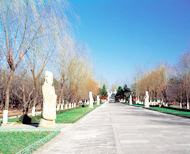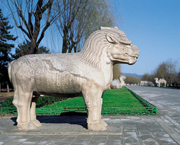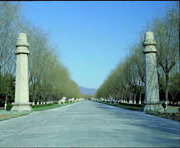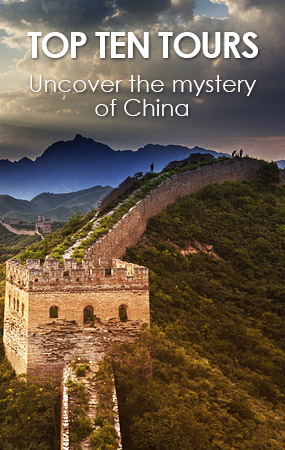The Sacred Way
At the southern end of the mausoleum area is a large memorial archway called Pailou. Built in 1540, it is now a monumental construction, built of white marble with five arches. Six rectangular pillars support it with beautiful bas-relief carvings (lions, dragons, lotus flowers).  It is 14 metres high and 28.86 metres wide.
It is 14 metres high and 28.86 metres wide.
One kilometre north of the archway is the main gate of the mausoleum area-the main gate of the palace called the Great Red Gate. Two tablets used to be placed on both sides of the gate which said: "Dignitaries, officials and other persons arriving here must dismount from their horses."
The central entrance was reserved for the body of the dead emperor, the living emperor had to use the left entrance when he came to pay homage to his ancestors.  One more kilometre north of the main gate of the palace is a stele pavilion, on the back of the stele marble was engraved resume of Zhu Di, the emperor of Chenzu of the Ming Dynasty and on the upper front was engraved characters. "Stele of Divine Merit and Sacred Virtue, Changling, Great Ming". The stele is carried on a marble tortoise, which, according to Chinese Legend, is the Son of Dragon, which the emperor called himself.
One more kilometre north of the main gate of the palace is a stele pavilion, on the back of the stele marble was engraved resume of Zhu Di, the emperor of Chenzu of the Ming Dynasty and on the upper front was engraved characters. "Stele of Divine Merit and Sacred Virtue, Changling, Great Ming". The stele is carried on a marble tortoise, which, according to Chinese Legend, is the Son of Dragon, which the emperor called himself.
Around the Pavilion are four Ornamental Pillars built with the same mythical beast on the tops, which face either inward or outward, which means hoping the emperor not to cling to the palace or not to forget to return to the Palace to handle state affairs.
Going inward from the stele Pavilion is the 3.5 Km long Sacred Way, which means the road leading to Heaven. The emperor, known as the Son of Heaven went through the sacred road to the sacrificial altar to converse with Heaven during his reign, naturally, after his death, he would also go through the Sacred Way back to heaven.
Alongside the Sacred Way are 18 pairs of marble figures lined up in antithesis, these marble figures, sculptured from whole stones, were erected over 500 years ago, the traditional way of putting over marble figures as guard of honour in front of the mausoleum began in the Han Dynasty which signified the dignity of the emperor, symbolising the good fortune and warding off evil influence.
This Sacred Way starts with two hexagonal columns called Wang Zhu on either side, they are carved with a cloud design.  Their tops are shaped like a rounded cylinder.
Their tops are shaped like a rounded cylinder.
Following this are on each side are lions, xie zhi (a mythical beast of feline family, with a mane and a horn on its head), camels, elephants, Qilin (a kind of imaginary animal with a scaly body, a cow's tail, deer's hooves and, horns on its head), horses. All six animals have two kneeling, two standing, 12 animals on each side and 24 animals in all. They were supposed to change guards at midnight.
A slight turn of the Sacred Way leads to the human statues. Even this slight turn is in conformity with the principle of Feng Shui (winds of heaven and the waters of earth). On each side stand two generals, two civil officials and two "retired" government officials, 6 on each side, and 12 in all. They are larger-than-life-size human statues.
The avenue of stone animals and statues ends at Ling Xing Gate, better known as the Dragon and Phoenix Gate.
The Sacred Way goes on beyond the Dragon and Phoenix Gate towards the chief tomb-Changling, Emperor Yongle's tomb.

